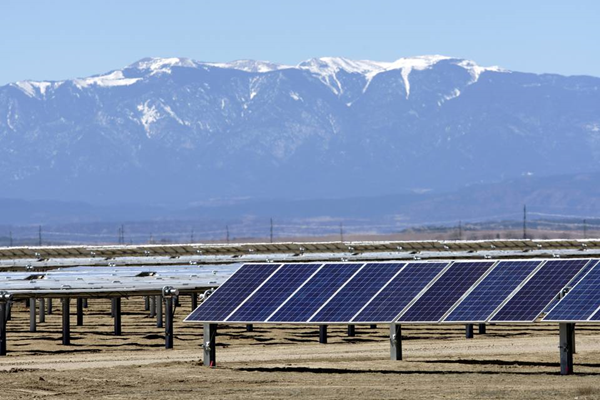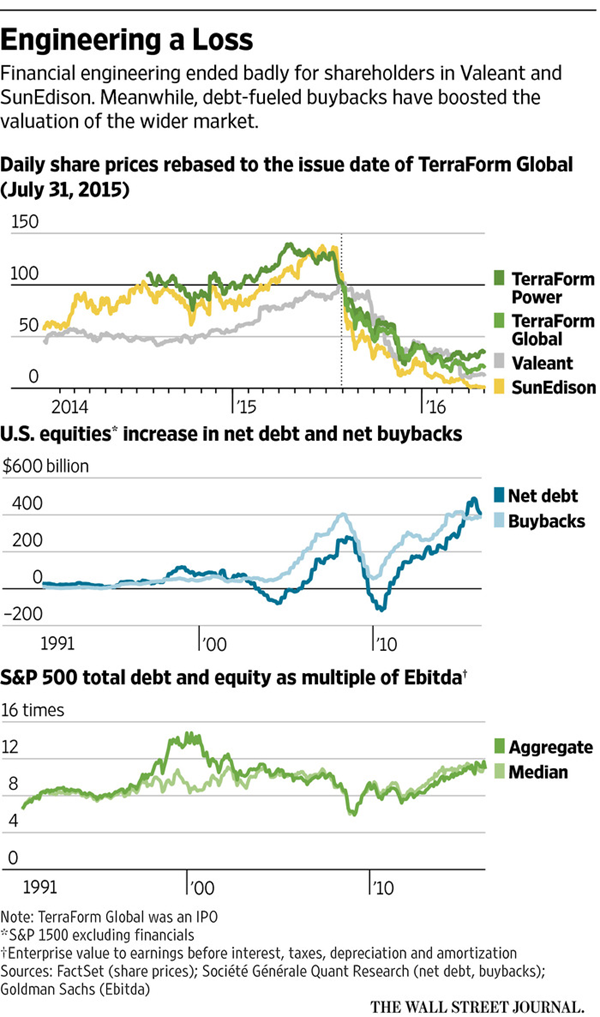|
THE
WALL STREET JOURNAL.
Markets |
Streetwise
Financial Engineering Shows Its Downside
Is the stock market engaged in unsustainable financial engineering
in an effort to satisfy shareholders?
|

A solar facility built by SunEdison in
Pueblo, Colo. SunEdison was among companies relying on financial
engineering to satisfy shareholders. PHOTO: RICK WILKING/REUTERS |
Valeant, SunEdison…the S&P
500?
Financial engineering has built vast
financial edifices, but all too often there is little of substance
providing support. The latest Wall Street constructs to crumble are
familiar names,
Valeant Pharmaceuticals International
Inc.
and
SunEdison Inc.
Both relied on financial engineering to
satisfy shareholders desperate for two items scarce in today’s weak
economy: growth, offered by Valeant, and income, supplied by
SunEdison’s so-called yieldcos.
Shareholders who avoided
both will be congratulating themselves, or thanking their luck. But
they should also be asking themselves a bigger question: Is the entire
stock market engaged in unsustainable financial engineering in an
effort to satisfy shareholders? Put another way: We know the market is
engaged in large-scale financial engineering in the form of a huge
ramp-up of leverage. Is it sustainable?
Valeant and SunEdison show
financial engineering in a bad light. Valeant used access to cheap
finance, in the form of its own highly valued stock and bonds, to make
ever-bigger acquisitions. Aggressive accounting allowed it to goose
its profits so long as the deals went on.
Because the company looked
as though it was providing strong growth, investors marked up its
shares, allowing it to do the next deal, and so on. Until it stopped.
Investors have learned
once again the problem of “roll-up” companies where the growth is
driven by accounting and valuation multiples rather than economies of
scale. The virtuous circle of cheap financing for takeovers leading to
higher valuations leading to cheap financing works only as long as
they keep doing deals. Valeant’s market value is down $78 billion from
its peak, about the same in today’s money as the total lost by
shareholders of Enron.
SunEdison, a solar
company, used more-novel financial engineering. It created twin
yieldcos,
TerraForm Power Inc.
and
TerraForm Global Inc.,
to raise cash from investors for its
completed projects. By clever use of tax losses, shareholders were
promised a high and rising dividend without corporate taxes, while
SunEdison secured upfront cash and retained control of the projects.
Renewable-power companies
created a line of yieldcos, gaining high valuations from
income-starved investors, helped by those demanding environmentally
friendly homes for their money. Almost all have been badly hurt by
changes to state tax breaks for green projects and the cheapening of
fossil fuels.
The financial engineering
behind Valeant and SunEdison has a bad name, at least for now. But
yesterday’s financial engineering often becomes widely accepted. In
the case of the engineering behind today’s high stock-market
valuations, it goes further: Borrowing to buy back shares is widely
welcomed.
The biggest 1,500
nonfinancial companies in the U.S. increased their net debt by $409
billion in the year to the end of March, according to Société Générale,
using almost all—$388 billion—to buy their own shares, net of newly
issued stock. Companies have become far and away the biggest customer
for their own shares.
As corporate profitability
slows, the obvious worry is that this debt will lead shareholders to
disaster. Total corporate debt is close to the proportion of the
economy hit during the debt-fueled bubble that ended in the 2008
collapse of Lehman Brothers.
According to David Kostin,
a strategist at Goldman Sachs, the debt and equity of the median U.S.
nonfinancial company is worth 11 times operating cash flow, higher
than in 2007 and higher than at the peak of the dot-com bubble. (This
widely used measure is known as enterprise value to earnings before
interest, taxes, depreciation and amortization).
So not only do companies
have a lot of debt, but shareholders love it. What could possibly go
wrong?
The case for calm is that
when interest rates are low, it is only natural that companies will
take on more debt. One illustration: The interest cover for U.S.
junk-rated nonfinancials, or the number of times operating profit
covers interest costs, is the strongest since at least 1997, according
to the Office of Financial Research, a U.S. watchdog created by the
Dodd-Frank Act.
The case for concern is
that this borrowed money wasn’t invested into productive projects that
would boost earnings in the future and so pay off the debt, but
instead was used to buy back shares. Corporate investment has picked
up recently, but overall buybacks are being funded from borrowing, as
Andrew Lapthorne, a strategist at Société Générale, points out.
This creates three risks.
First, rising interest rates for corporate debt would have a much
bigger impact on profits and shareholders than usual, and could lead
to a wave of defaults, as the energy sector showed.
Second, more caution in
the bond market, perhaps caused by recession, could make it hard for
companies to roll over debt; again, the energy sector has been a
painful demonstration of what happens to highly indebted companies
when they lose access to credit.
Third, if companies
themselves become more cautious, it could remove the biggest buyer of
stocks from the market. Share buybacks have helped support prices and
earnings per share even as profits have fallen back to mid-2012
levels.
If companies stop
borrowing to finance buybacks, another generation of shareholders will
discover the downside of financial engineering.
Write to
James Mackintosh at
James.Mackintosh@wsj.com
|


